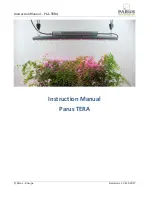
2.
Attach the isolation valve to the bottom of the
cabinet stand (9):
a.
Insert the two screws (54) through flat
washers (19), the base housing (201), and
then insert into the bottom two holes of the
cabinet stand (9).
b.
Thread the washer (19), lock washer (22),
and hex nut (23) onto the back screw.
c.
The front screw also holds the bottom bracket
for the isolation valve cover (99). Slide the
bracket (98) onto the front screw, followed
by the washer (19), lock washer (22), and
hex nut (23).
Tighten all 4 screws after they are installed.
3.
Attach the inlet fluid tube, using one wrench to
orient the elbow fitting (72) and one wrench to
tighten it to the housing (218).
4.
If the outlet fluid fitting and/or the check valve
were removed, reinstall using thread sealant.
Position the outlet so that it is pointed down and
slightly forward.
NOTICE
NOTICE
NOTICE
Incorrect orientation of the fluid components
can cause the system voltage to drop below
normal operating voltage. Low system
electrostatic voltage can cause arcing that
damages system components. Orient the
check valve to maintain air space between the
fluid hose and other components.
5.
Place the two clamps (101) over the top of the air
cylinder (227) and attach the top sensor to the
top clamp and the bottom sensor to the bottom
clamp.
6.
If the sensor positions were indicated during
disassembly, attach the clamps into position. If
the position was not indicated, follow the steps in
Adjust the Isolation Valve Sensors, page 92
7.
Fill the wash fluid bottle (W) with HydroShield
cleansing solution above the minimum line
marked on the bottle. Replace it in the cabinet.
Reconnect the tube (91).
8.
Reconnect the three push-to-connect air
line fittings (239) to the isolation valve: top,
middle, bottom. For connection details, see
Pneumatic Connections, page 109
9.
Before enclosing the isolation valve in the
isolation valve cover (99), ensure that the
isolation valve shuttle (218) has a clear path to
travel up and down:
• Make sure that there are no air lines or cables
in the path of the shuttle.
• Make sure that the flexible hose between the
inlet valve (F) and the isolation valve (G) is not
curled or hanging in the path of the shuttle.
If necessary, loosen the fittings at each end,
hold the hose in place as shown below, and
retighten the fittings to ensure that the hose
doesn't rub on anything.
10. Replace the isolation valve cover (99) and tighten
the top and bottom screws (99a).
11. Reinstall the electrostatic shield (12) inside the
cabinet.
12. Close the cabinet door and use a flat blade
screwdriver to secure the door shut.
3A8493A
91
Содержание HydroShield WABL00
Страница 118: ...Parts Notes Notes Notes 118 3A8493A...
















































